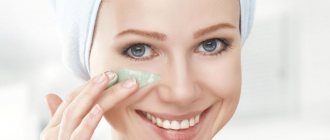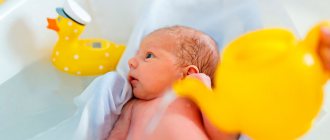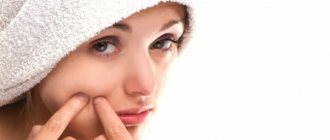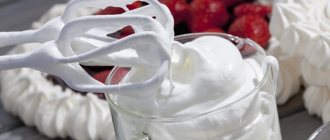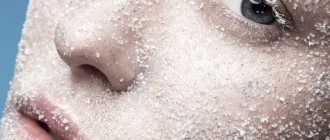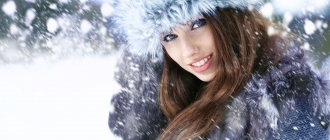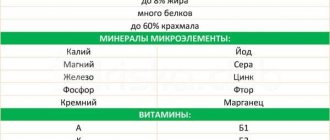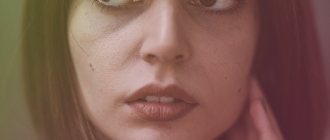How can men take care of oily and sensitive skin? (photo: @menwithskincare) Men naturally have oilier, thicker, and more sensitive skin than women. It resists age-related changes better, that is, wrinkles appear on it much later, but it is more prone to inflammation, redness, rashes, blackheads, enlarged pores and oily sheen. To look perfect, men should follow two rules of facial care:
- cleanse your face every morning and evening using special exfoliating products,
- Be sure to moisturize and nourish the skin with products with soothing and mattifying properties.
Below are the best products from these two categories that will help men forget about skin problems
Male and female: what techniques and skin care products can be adopted from each other Read
Stage one: cleansing (photo: @menwithskincare)
Causes of increased oily skin
There are several reasons for increased oily skin, and the main one is hormonal.
In children, the skin is smooth and soft; changes begin after 12 years, when a profound restructuring of the body occurs. Many teenagers (both boys and girls), entering puberty, are faced with the problem of oily skin and acne.
Men have oily skin more often than women because the main male hormone, testosterone, activates the sebaceous glands. Women suffer from increased oily skin in their youth. In the second phase of the female cycle, the hormonal background changes sharply, and, as a result, the secretion of sebum increases.
The second reason for oily skin is the influence of external factors. This is an unfavorable environmental situation, tobacco smoke, nervous stress.
Ultraviolet
radiation aggravates the problem of oily skin. With prolonged exposure to bright sun, the skin becomes dry, thickens, and roughens, which makes it difficult for sebum to come out and causes clogging of the glands (this is what causes acne).
An unhealthy diet with a predominance of fatty, fried, spicy foods activates the functioning of the skin glands.
Violation of hygiene rules. It is very important to wash your face in the morning and regularly treat oily areas of the skin with special compounds.
Too warm air indoors and outdoors causes the sebaceous glands to work more intensely.
Sebum production is uneven and depends on the area of the body. On the face, back, and chest, the skin can be oilier.
The use of low-quality oil- or fat-based cosmetics can cause skin diseases.
With a weakened immune system, skin problems are also observed, since the skin is the body's main protective barrier.
Wide pores on a man's face
Wide pores on a man’s face occur for the following reasons:
- the skin has not been thoroughly cleansed or facial skin care is incorrect, cosmetics are inappropriate;
- a lot of toxins have accumulated in the body;
- the person has bad habits (drinks a lot of alcohol, smokes, drinks a lot of coffee);
- eats poorly and drinks little water. In case of frequent consumption of fast food, spicy, fried, sweet, fatty foods, lack of sufficient water, the skin suffers;
- problems with hormonal levels. Enlarged pores may indicate certain diseases associated with the thyroid and pancreas.
It is also worth remembering such causes of enlarged pores as heavy decorative cosmetics, taking specific medications, weak immunity, and constant stressful situations. Before you treat pores, you need to understand what the cause is.
Reviews about oily skin and how to care for it
“For three years now I have been going to cosmetologist Ksenia Vasnina at Abrielle. Every year I undergo a course of 6-8 ultrasonic cleaning procedures: once a week a cosmetologist cleanses me, and the quality of my skin noticeably improves. I am simply delighted with Olga's magical hands. Despite the procedure, I don’t have to sit at home with redness; I can meet friends or go on business the same day. In literally forty minutes my skin is transformed, and my pores are noticeably narrowed.” Tatyana, 35 years old
Read this and other reviews about cosmetology here.
Features of men's skin
Men's skin differs from women's for physiological and hormonal reasons.
Distinctive characteristics of men's skin:
thick, with uneven relief;
produces more sebum than women, therefore more oily;
prone to clogged pores and the formation of comedones;
collagen fibers are denser than those of women's skin;
with more active blood flow;
less often sensitive.
Men's skin is most often of the oily type © iStock
Complications with oily skin
One of the manifestations inherent in oily skin is comedones. There are two types of comedones: black and white. Black (open) comedones clog the sebaceous gland channels and cause the formation of acne. White comedones (closed comedones, milia) do not provoke inflammation. The cause of comedones is a blockage of the gland. Contrary to popular belief, black comedones get their color not because of dirt that comes from outside, but because of the products of cell breakdown and fat oxidation. These substances contain melanin, a pigment present in skin cells, which explains the color of black comedones. White closed comedones contain light sebum, which in this case does not come into contact with air and does not oxidize.
Oily skin does not cause complications with regular and proper care. It even has benefits: if you take good care of oily skin, it will look young longer. For those with oily skin, wrinkles begin to form later. But in young years, with increased hormonal levels, oily skin brings people a lot of worries. It causes unsightly shine, large pores, comedones and acne. Often, increased oiliness is observed not only on the skin of the face, but also on the back, chest, and arms. For a tenth of people, these problems remain even after 30 years.
There are skin diseases that are treated by both dermatologists and cosmetologists. These include things that everyone may have, that you may not pay attention to, but that you really want to get rid of, since it affects the aesthetic appearance of the skin. So, these are problems that spoil the appearance and cause not so much physical as mental suffering. We will focus here only on the most common ones - Acne, seborrhea and various formations on the skin.
Acne vulgaris or juvenile acne
Acne
– the most common skin disease in adolescents and young people, that is, the most socially active part of the population. This unpleasant disease affects about 85% of people aged 12 to 25 years in European countries, so clear skin at this age is the exception rather than the rule. The presence of inflamed pimples, pustules and ulcers, blackheads (comedones), spots and scars, a greasy, untidy appearance of the skin in the most visible places causes difficulties in communication, professional organization, reduces self-esteem, and often leads to the formation of significant psycho-emotional disorders, even the desire for complete isolation. Some young people stop leaving home, give up school and work, become isolated, and eventually a minor and completely banal skin problem develops into a personal tragedy. A patient who consults a dermatologist about acne has serious psychological problems. Shyness, guilt, a sense of social unacceptability, anger, depression, and disbelief in the possibility of a cure are expressed to varying degrees. Intense experiences aggravate the course of the disease. In stressful situations, patients, especially women, pick at the skin and squeeze out acne, which further worsens the appearance of the skin due to associated inflammation. In such injured areas, scars and spots remain that do not go away for a long time.
Acne
– a long-term disease, often exacerbating (in girls, usually monthly) and often resistant to treatment. Currently, we know much more about acne than ten years ago, and a competent specialist can always help a patient. In this regard, the opinion that existed in the past that acne will go away on its own with age, and therefore there is no need to waste effort on treating it, now sounds simply absurd. It is not always possible to immediately find the right individual approach, but the efforts made and perseverance shown are always rewarded with a good result. Specialists have a number of effective medications from different groups in their arsenal. The choice of drug depends on the form of the disease, the predominance of certain symptoms, the gender of the patient, and the presence of contraindications.
Acne is most often divided into:
- acne with a predominance of comedones (white and blackheads with mild inflammation);
- papulopustular acne (there are comedones, inflamed nodules - what are usually called pimples, pustules, sometimes single large painful lumps, gradually turning into ulcers such as boils);
- conglobate acne (along with all of the above, there are long-term painful lumps that leave pronounced scars after healing).
Over time, most patients develop the habit of squeezing out comedones and pustules, constantly touching the inflamed skin, which is why bloody crusts, spots, and superficial scars are added to everything described.
Many factors take part in the development of acne, the action of which is ultimately realized in the pilosebaceous follicles. Not all follicles are affected, but only those with a special structure, located on the face and in the upper part of the body, with large sebaceous glands, wide (up to 2.5 mm) ducts and thin, almost invisible hairs. The sebaceous glands are the target organ for sex hormones, especially testosterone. Under the influence of testosterone, produced by the gonads especially actively in adolescence, the size and number of sebaceous glands increase significantly, the production of sebum increases, and its composition changes. In addition, in the development of acne, disruption of the keratinization of the sebaceous gland ducts, difficulty in the outflow of sebum to the surface of the skin, increased proliferation of microbes in accumulated sebum and subsequent inflammation are essential. With the help of modern medicines it is possible to influence almost all factors involved in the development of the disease.
At the initial manifestations of acne (usually at the age of 8–13 years), when the clinical picture is dominated by increased oily skin and comedones (whitish nodules and blackheads), and there are not many inflammatory elements, preparations of retinoic and salicylic acids are used externally. Both acids have the property of dissolving comedones, and salicylic acid has a much weaker effect in this regard. For papulopustular acne, it is advisable to use antibiotics, retinoids, benzoyl peroxide (benzoyl peroxide), traditional external agents (salicylic, chloramphenicol, resorcinol alcohols). Severe forms of acne, including conglobate acne, should be treated with retinoids prescribed orally, and only if there are contraindications, other treatment methods (antibiotics, immunomodulators) should be used. As with papulopustular acne, it is preferable to use a combination of different drugs.
Problems solved during the treatment process and ways to solve them:
- reduction in sebum production (retinoids, especially retinoic acid, hormonal drugs - estrogens, progestins or antiandrogens, spironolactones);
- reduction of inflammation - antibiotics (tetracyclines, erythromycin, lincomycin, clindamycin) and local anti-inflammatory and microcirculation-improving agents, including zinc oxide, sulfur, tar, ichthyol, resorcinol;
- prevention of the appearance and elimination of comedones (retinoids, especially retinoic acid, salicylic alcohol);
- preventing the appearance of scars (early initiation of treatment, retinoids, curiosin, contractubex, avoiding trauma to rashes).
Features of acne treatment with drugs of different groups
Currently, retinoids are the most effective group of drugs for the treatment of acne. Their use solves several problems at once - reducing sebum production and inflammation, preventing the appearance and elimination of comedones and scars. Two isomers of retinoic acid (tretinoin and isotretinoin) are used for external treatment of acne. Roaccutane and Retinol palmitate are used for internal treatment of conglobate acne and common papulopustular acne resistant to other external agents.
Roaccutane (isotretinoin) (Hoffmann-La Roche, Switzerland) is available in capsules for oral use of 10 and 20 mg (30 pieces per package). Prescribed at the rate of 0.5–1.0 mg/kg body weight per day, taken in equal parts 2 times a day after meals for 12–16 weeks. If repeated courses are necessary, the break should be at least 8 weeks. Roaccutane is a highly effective drug, however, its use is limited by high cost and many side effects. Treatment is always carried out under the supervision of a specialist.
Retinol palmitate
(vitamin A) is a domestic drug, it is produced in capsules for oral use at 33,000 and 100,000 IU, as well as in an oil solution at 100,000 IU/ml. Effective doses for acne are at least 300,000 IU per day. The course of treatment is 12–16 weeks. The intervals between courses are 4–8 weeks. Retinol palmitate is inferior in effectiveness to Roaccutane, however, it is better tolerated and the cost is much lower.
For external treatment of acne, preparations containing all-trans retinoic acid (tretinoin) and 13-cis-retinoic acid (isotretinoin) are used. All-trans retinoic acid is contained in the following foreign preparations: Retin-A – 0.05% cream in tubes of 30 g (Silag, Switzerland), Lokatsid – 0.05% cream in tubes of 30 g and 0.1% solution in 15 ml bottles (“Pierre Fabre”, France). External preparations with 13-cis-retinoic acid, which has higher bioavailability, are produced only in Russia - Retinoic ointment 0.1% and 0.05% and Retasol® (FNPP "Retinoids"). It is recommended to apply ointments and solution to previously cleansed skin 1-2 times a day. Once the effect is achieved, it is recommended to reduce the concentration or reduce the frequency of application of the drug. Duration of treatment is 12–16 weeks.
Drugs from the retinoid group have a number of side effects. The most serious of them are teratogenicity and embryotoxicity. In this regard, women of childbearing age are prescribed retinoids with reliable contraception and a negative pregnancy test. In the outpatient card, when prescribing systemic treatment, a note is usually made about the woman’s awareness of possible side effects, and abroad dermatologists offer women to fill out and sign a special form in order to avoid further prosecution in the event of side effects. External treatment with drugs of this group is stopped when pregnancy occurs. Retinoids do not have a negative effect on the reproductive function of men.
In the first or second week of treatment, most patients experience an exacerbation reaction, expressed in redness, moderate itching, and peeling of the skin. The patient should be warned about the reaction, and if he is facing important life events at this time, then it is better to postpone the start of treatment. Typically, these phenomena go away on their own within a few days, after which a lasting improvement occurs. Dry lips, cracks in the corners of the mouth, peeling of the skin are common during the treatment process; they are eliminated by using a neutral moisturizing cream for the face and body, hygienic lipstick or lip gel, and limiting the use of detergents when washing and washing. With systemic administration of retinoids, dry nasal mucosa, nosebleeds, conjunctivitis, urethritis, increased levels of transaminases and lipids in the blood, and increased sensitivity of the skin to sunlight are sometimes observed. Taking this into account, before the start of treatment and monthly during treatment, a biochemical blood test is performed, it is recommended to use sun protective creams, and avoid direct sunlight.
Contraindications
pregnancy and lactation, abnormalities in biochemical blood tests (hyperlipidemia, increased activity of ALT, AST and alkaline phosphatase), renal and liver failure, hypervitaminosis A, drug intolerance. Retinoids cannot be prescribed simultaneously internally and externally, ultraviolet irradiation, drugs with keratolytic and exfoliating effects, exfoliating cosmetic procedures and products (scrubs, peeling). The effect of retinoids is weakened by the simultaneous use of glucocorticosteroid drugs and alcohol intake.
Antibiotics
Of the wide range of antibiotics used to treat acne, only tetracyclines, erythromycin, lincomycin, josamycin and clindamycin are used. Prescription of antibiotics orally is indicated when a large area of skin is affected, with a predominance of pustules. During pregnancy, only erythromycin can be used among these drugs.
Antibiotics of the tetracycline group have an advantage over other groups, since they are lipophilic and easily reach the main object of their action - the sebaceous glands. They can be prescribed for a long time - 2-3 months in a small dose. In this case, they block the production of bacterial lipases, the main link in the development of inflammation. A significant advantage of this method is the possibility of long-term treatment without disturbing the composition of the intestinal flora. The daily dose of tetracycline is 1000 mg (10 tablets of 0.1 g or 4 tablets of 0.25 g), doxycycline hydrochloride is 50 mg (1 capsule of 0.05 g once a day), Unidox Solutab is 50 mg ( 1/2 tablet of 0.1 g), metacycline - 600 mg (2 times a day, 0.3 g). Antibiotics of the tetracycline group in the indicated doses are always well tolerated, and side effects characteristic of long-term use at a bacteriostatic dose do not develop. Tetracyclines are contraindicated in concomitant fungal diseases, pregnancy (last trimester), liver dysfunction, leukopenia, children under 8 years of age, and kidney disease. During treatment, insolation is not recommended, ultraviolet irradiation, retinoids for internal use, hormonal contraceptives, psychotropic, anticonvulsant and antidiabetic drugs are not prescribed. Absorption of tetracycline is weakened in the presence of food, especially milk and fermented milk products, as well as trace elements - aluminum, calcium, magnesium, iron. Their use should be avoided during treatment. Tablets are taken separately from meals.
Doxycycline, Metacycline and Unidox Solutab are better absorbed and can be taken with or after meals with plenty of water. Unfortunately, microorganisms quickly develop resistance to drugs in this group, and when re-prescribed they are rarely effective.
Erythromycin belongs to the group of macrolides, the daily dose is 500-1000 mg divided into 3-4 doses 1-1.5 hours before meals. The drug is available in tablets or capsules of 0.1, 0.25 and 0.5 g. Possible side effects include nausea, vomiting, diarrhea, and liver dysfunction. The drug is contraindicated in case of individual intolerance, liver diseases with impaired liver function. It should be borne in mind that erythromycin is inactivated by dairy products and acidic drinks, and also increases blood levels and enhances the toxic effect of carbamazepine (tegretol, finlepsin) and theophylline.
Clindamycin (lincomycin group) is prescribed in a daily dose of 0.6 g, divided into 2 doses, available in capsules of 0.15 g and under the name Dalacin C - 0.15 and 0.3 g. The course of treatment is 7–10 days. Possible side effects include dyspepsia (nausea, vomiting, diarrhea), liver dysfunction. The drug is incompatible with erythromycin and B vitamins. Lincomycin is prescribed in a daily dose of 1500–2000 mg (2 tablets 3–4 times a day), available in capsules of 0.25 g. The duration of treatment and side effects are similar to clindamycin.
Josamycin or vilprafen in a daily dose of 1000 mg (1 tablet 2 times a day between meals) is used for 2–4 weeks, then 1 tablet. within 8 weeks. Possible side effects include dyspepsia (nausea, vomiting, diarrhea), liver dysfunction. The drug is incompatible with lincomycin and weakens the effect of hormonal contraceptives.
If antibiotics are intolerant, they resort to sulfonamide drugs, usually co-trimoxazole (Biseptol, Septrin, Groseptol, Cotripharm 480). The drug is prescribed 480-960 mg (1-2 tablets) 2 times a day during or after meals with an interval of 12 hours. During treatment, it is recommended to drink plenty of fluids, monitor the condition of the blood and urine, avoid solar and ultraviolet irradiation, and do not prescribe ascorbic acid.
It is logical to assume that local use of the above antibiotics may be much more effective and safer than internal use. However, research shows that topical application of erythromycin, clindamycin and tetracycline is effective only for mild acne, especially in combination with zinc, retinoids or benzoyl peroxide. External use of 1% erythromycin ointment (Ung. Erythromycini 1%) has a positive effect only in combination with other external and internal agents; gel with clindamycin Dalacin T (Pharmacia, USA) is more effective. Easy to use Eryderm (Abbott Labor, USA) – 2% solution of erythromycin. Levomycetinic, boric, and resorcinol alcohols are also used to dry and cauterize individual rashes. Combination preparations that are effective are Zinerit (Yamanouchi, Netherlands) - a solution of erythromycin and zinc acetate and Benzamycin, gel for external use, in 20 g tubes (Rhone-Poulenc Rorer, USA), containing 3% erythromycin and 5% benzoyl peroxide. All of the above drugs are prescribed 2 times a day. Like antibiotics prescribed orally, external medications tend to cause the development of antibiotic-resistant strains of microorganisms, so their repeated prescription is often ineffective. Resistance of Propionibacterium acnes strains (the main microorganism that multiplies in the sebaceous glands of patients) to commonly used antibiotics was found in 60% of patients. Increased resistance depends on the duration of therapy; resistance to erythromycin develops more often.
Other antiseptics and disinfectants. One of the successful modern approaches to treatment is the use of benzoyl peroxide, a lipophilic compound due to the presence of a benzoic acid residue in its composition. Benzoyl peroxide applied to the skin breaks down under the influence of air into peroxide and inactive benzoic acid, which remains on the surface of the skin. Active oxygen compounds damage the walls of bacteria, destroying them, and the content of fatty acids decreases, which prevents inflammation. At the same time, the same compounds also have a damaging effect on the horny scales, which is clinically expressed by peeling of the skin that accompanies the therapeutic effect. Benzoyl peroxide preparations have no effect on comedones, so they are not used if they predominate. Various companies offer this drug under the names Benzacne (Polfa, Poland), Desquam (Bristol-Myers, USA), Oxy 5 and Oxy 10 (SmithKline Beecham, UK), Baziron (Galderma, France). Benzoyl peroxide is available in the form of 2%, 5%, and 10% gel, 5% and 10% lotion. Treatment begins with applying a lower concentration of the drug to the face, then it is increased. A higher concentration is immediately applied to the back and chest. Benzoyl peroxide is applied to previously cleansed skin once a day. Side effects include an exacerbation reaction in the first days of use, dryness and flaking of the skin, discoloration of hair and linen when the drug comes into contact with them. Intolerance is common, so before starting treatment it is recommended to conduct a skin test - the drug is applied to a small area of skin on the flexor surface of the forearm for 48 hours. If there is no itching or redness, you can apply the drug to your face.
A combination of topical application of benzoyl peroxide in the morning and Retinoic ointment in the evening has a good effect, especially in the presence of comedones.
Azelaic acid inhibits the growth of microorganisms and reduces the content of free fatty acids on the skin surface. Skinoren cream or gel (“Schering”, Germany), containing 20% and 15% azelaic acid, respectively, is applied to the facial skin (both affected and rash-free areas) 2 times a day. When used, local skin irritation is possible. Skinoren is used in the complex treatment of acne; using it as an independent remedy usually does not bring success.
Zinc hyaluronate is part of the Curiosin gel (Gedeon Richter, Hungary), has a healing and antimicrobial effect. It can be used for a small number of rashes, since the effectiveness of the drug is low. The gel is applied to cleansed skin twice a day; a burning sensation and redness of the skin at the application sites are possible.
Povidone-iodine (Betadine) is used to lubricate pustules in a concentrated (10%) or diluted 1:1 solution with water 1-2 times a day. It is undesirable to use in fair-skinned and red-haired patients due to increased sensitivity to iodine. The diluted solution cannot be stored.
For a small number of comedones in the initial stage of the disease, salicylic alcohol 2–3% is effective. It is used 2 times a day, being careful not to apply to the entire affected area to avoid drying it out, but only to individual areas.
Sulfur is an anti-inflammatory agent; it is included as one of the components in most external agents (ointments and mash) traditionally used in the treatment of acne. However, in recent years, its comedogenic effect has been discovered, i.e. it can cause the formation of comedones.
Hormone therapy
Sex hormone therapy is only possible for women. Estrogens (ethinyl estradiol) and antiandrogens (cyproterone acetate, spironolactone) can be used for treatment. Estrogens reduce the secretion of the sebaceous glands, although not as significantly as retinoids. They can be used simultaneously with topical retinoic acid, antibiotics or benzoyl peroxide, which increases the therapeutic effect. To achieve a good result, estrogens must be given for a long time - at least 5 cycles. The first signs of improvement are noticeable only towards the end of the second or third cycle. Estrogen has many side effects - nausea, fluid retention in the body, swelling of the legs, weight gain, breast tenderness, skin pigmentation, increased risk of vascular thrombosis. Risk factors for side effects include smoking, alcohol consumption, obesity, and vascular diseases. Cyproterone acetate for the treatment of acne is used only in combination with estrogens. Of the combination drugs, Diane-35 and Janine (Schering, Germany) are used. The drug is prescribed 1 tablet per day, starting from the first day of the cycle, for 21 days with a break of 7 days. The antiandrogenic drug Cyproterone or Androcur (“Schering”, Germany) is prescribed 1 tablet (10 mg) per day, starting from the first day of the cycle for 15 days, a new course begins 4 weeks after the start of the first. Glucocorticosteroid drugs are prescribed orally or parenterally only for abscess and fulminant acne, which is extremely rare. External use of corticosteroid ointments is not indicated.
Drugs of other groups
Zincteral (Polfa, Poland) contains zinc sulfate, a deficiency of which is often found in patients with acne. Tablets of 0.124 g are prescribed 1-2 times a day during or immediately after meals for 1-2 months. There may be nausea in the first week of use. The drug enhances the effect of retinoids, but weakens the effect of tetracyclines. Homeopathic treatments include injections of Cutis compositum or Traumeel (Heel, Germany). Herbal medicine is still widely used as an auxiliary means - applications of badyagi pulp for resorption of individual large nodes, lotions with green tea, calamus rhizome, raspberry shoots. Infusions of plants with estrogenic effects (hop cones, sage leaves) are prescribed internally.
Skin care
Many patients, feeling the increased sebum secretion characteristic of acne, try to wash their face as often as possible using soap and a sponge. At the same time, the skin dries out, but sebum secretion does not become significantly lower, since fat is washed out only from the surface of the skin, without affecting the sebaceous glands themselves, located in its depths. In this regard, frequent washing of the skin (no more than once a day), or the use of sponges and washcloths is not recommended to avoid irritation and injury. Many people now use antimicrobial soap. But it changes the state of the microbial flora only on the surface of the skin and does not have a significant effect on the course of the disease. At the same time, antimicrobial additives contained in soap can cause irritation or allergic reactions. To cleanse the skin, it is better to use soft neutral soap for sensitive skin or special cosmetics intended for this purpose (cleansing with milk, then tonic), and to eliminate the shine of the face associated with the release of sebum to the surface, use cosmetic wipes or special mattifying wipes facilities. The widely held belief that decorative cosmetics should not be used for acne has also now been revised. Modern high-quality cosmetics that do not irritate the skin, mask existing defects well, do not significantly disturb sweating, and are not applied to the skin in a thick layer and can be used during the day. It should be removed at home. Some medications require the use of sunscreen. It is better to prefer gels and milk, and also be sure to quickly remove them from the skin indoors. Scrubs and peels may be recommended to smooth the surface of the skin and give it freshness, but are contraindicated during treatment with retinoids, benzoyl peroxide and tetracyclines.
The use of therapeutic masks with a drying effect and detergents is limited during treatment with retinoids and alcohol solutions. If there are pustules on the skin and severe inflammation, massage and cosmetic cleansing of the skin are contraindicated.
Diet
Both in the past and now, most dermatologists always recommend following a fairly strict diet. Our long-term observations have shown that the benefit of such restrictions is small, and only in a few patients there is a clear connection between eating certain foods (mainly chocolate) and increasing rashes. We usually recommend that patients adhere to a reasonable diet, without excesses, and include more fermented milk products and greens in their diet. However, 2-3 days of fasting during an exacerbation always gives a positive result. In general, when prescribing modern therapeutic agents, there is no need to follow any diet to achieve a good result. If the patient is to take part in a festive feast, it is better to stop taking oral medications for 2-3 days and prescribe enterosorbents (Polyphepan, Enterosgel, etc.).
Our recommendations for treating acne
- Initial stage - a few small black dots appear on the nose and forehead (usually in children) - Salicylic alcohol, Retinoic ointment, Skinoren, medicinal cosmetics.
- The same, but for significantly oily skin - Retinoic ointment, Salicylic alcohol.
- Numerous black spots and individual inflammatory nodules and pustules - Retinoic ointment, Salicylic alcohol, on pustules - alcohols with antibiotics, Dalatsin T, Povidone-iodine.
- The predominance of inflammation with a small number of comedones - Retinoids (Retinoic ointment, Retasol®), benzoyl peroxide (Benzacne, Desquam, Oxy 5 and Oxy 10, Baziron), external preparations with antibiotics (Dalacin T, Zinerit, Eriderm, Benzamycin).
- The predominance of pustules in a common process (face, back, chest) - antibiotics, in some cases - retinoids internally (Roaccutane, Retinol palmitate), externally - benzoyl peroxide, disinfectants.
- Individual large painful ulcers on the face - antibiotics, externally - antibiotic ointments and benzoyl peroxide.
Seborrhea and seborrheic dermatitis
In recent years, what was previously united by one term “seborrhea” has begun to be divided into 2 concepts – seborrhea of the head and seborrheic dermatitis (damage to smooth skin).
Seborrheic dermatitis
– chronic inflammatory skin disease. It affects 1-3% of adults (mostly men). Seborrheic dermatitis, along with acne, is a disorder of sebum secretion. Indeed, both diseases are often combined in the same person and affect the same areas of the skin - the so-called “seborrheic zones” - the face, chest (décolleté area) and the middle part of the back along the spine (interscapular region), where the largest sebaceous glands with wide ducts that secrete large amounts of sebum. Sebaceous glands of this type actively develop and increase in size during puberty. The composition of sebum also changes, it becomes more viscous, the components it contains contribute to increased keratinization, which corresponds to peeling visible to the eye. Smaller glands, but also secreting large amounts of sebum, are located on the scalp. Their purpose is to provide fat lubrication to the hair and make it invulnerable to external influences. These glands also become more active during puberty. In adolescents and adults, the mildest form of seborrheic dermatitis is characterized by flaking of the skin and its excess oiliness without inflammation - on the scalp it is dandruff, and on the face and chest - accumulations of fatty scales in the skin folds - near the wings of the nose, in the nasolabial fold, on the bridge of the nose , less often - on the chest and back. Fatty scales soaked in sebum serve as a good breeding ground for the development of lipophilic fungi Malassezia furfur or Pityrosporum ovale. In turn, the immune system reacts to them with the development of allergic dermatitis, the disease enters its second, more unpleasant phase, and is no longer limited to mild manifestations. Itching, burning, at first mild, then more intense redness of the skin, severe peeling, and hair loss appear. The manifestations of the disease are aggravated by the patients themselves - constant scratching, attempts to remove crusts, remove accumulations of scales from the hair, the use of “folk” remedies, and the most powerful ones, inevitably lead to increased redness, the appearance of scratches and wounds, the proliferation of other microbes, and the development of complications of the pustular process. It is usually in this condition that patients turn to a dermatologist, although everything could have been corrected much earlier.
For any manifestation of the disease, you should pay attention to your diet. Sometimes its correction is enough to prevent further development of the disease. Alcohol, sweets and starchy foods should be limited, regardless of the type of food. For itching and inflammation, smoked, salted, pickled foods, spicy seasonings, strong broths, instant coffee, citrus fruits, kiwi, pineapples and juices from them are also temporarily limited.
Treatment depends on the stage of development and clinical picture of the disease. If dandruff appears without inflammation, you can limit yourself to only external treatment; in more serious cases, internal treatment is also necessary. External treatment includes keratolytic, glucocorticosteroid, antiseptic, disinfectant and antifungal agents. Antifungal drugs are usually the starting point for treatment and can be used long-term without the risk of side effects. Various dosage forms are used - creams, gels, shampoos. Shampoos with antifungal substances - Nizoral, Keto-plus, Perhotal, Mycozoral, Sebozol contain 1-2% ketoconazole. Ti/Jel anti-dandruff shampoo contains 0.75% piroctone olamine and 2% salicylic acid. Creams and gels are applied 2 times a day, shampoos - 3 times a week. Various other medicinal substances that also have antifungal properties include zinc pyrithioneate, tar, sulfur, resorcinol and selenium disulfide. Medicines containing these compounds are available in the form of shampoos for the treatment of dandruff (Friderm-tar, Ti/Jel-Newtar, Friderm-zinc) and ointments for the treatment of smooth skin lesions (Skin-cap, birch tar, tar and sulfur-tar ointments ). Prescription forms are also used: Vidal milk, alcohol solutions with sulfur, boric acid, tar. After hair treatment, it is necessary to change combs, hair brushes, and hats.
For severe inflammation, anti-inflammatory, antiseptic and disinfectants are used. For weeping and severe swelling of the lesions, lotions with resorcinol 1% and herbal decoctions are used. The crusts are usually lubricated with alcohol solutions (salicylic, resorcinol, boric alcohols). Corticosteroids have a rapid anti-inflammatory effect - they are used on the head in the form of solutions - Elokom, Diprosalik (Schering-Plough USA), Lokoid (Janssen-Cilag Belgium), Belosalik (Belupo, Croatia), on seborrheic areas - in the form of ointments and creams - Elokom, Diprosalik, Belosalik, Hydrocortisone ointment. It should be noted that on the skin of the face, which is much thinner than in other areas, only non-fluorinated glucocorticosteroids can be used in the form of easily absorbed creams and emulsions (Advantan emulsion, Elokom cream, Lokoid cream) or weak (Prednisolone, Hydrocortisone) ointments. Drugs in this group are not suitable for long-term use due to the risk of undesirable effects - thinning of the skin, dilation of blood vessels, appearance or worsening of acne. When it is possible to relieve acute inflammation (usually in 3-5 days), and with residual peeling, they are replaced by drugs containing vitamin A - emulsion-based ointments Videstim®, Radevit® (FNPP “Retinoids”, Russia). It is known that vitamin A (retinol palmitate) reduces sebum secretion by reducing the size of the sebaceous glands and keratinization, and also has the properties of a local immunomodulator. Videstim® contains 0.5% retinol palmitate on an emulsion basis, Radevit® - 1% retinol palmitate, ergocalciferol and tocopherol acetate (vitamins A, D and E). The drugs are used for a long time, including for the purpose of preventing relapses. In recent years, the local immunomodulator pimecrolimus, supplied to Russia under the name Elidel, has also been used in treatment. Keratolytic agents are used for severe peeling and crusting. Apply sulfur-salicylic ointment 2-5% 1.5-2 hours before washing hair under a scarf, on the face - 1 hour before washing, 10% ointment with urea Carboderm (Ukraine). A particularly good effect is brought by combination drugs that combine the keratolytic properties of salicylic acid and anti-inflammatory glucocorticosteroids - Diprosalik, Belosalik. Internal remedies include vitamin A (retinol palmitate) in a daily dose of 100,000–200,000 IU (once at night for 2 months), B vitamins, in particular brewer’s yeast (Merz Germany and domestic companies), brewer’s yeast with the addition of zinc and selenium Nagipol, multivitamin-mineral complexes, preparations with selenium (Selevit, Triovit), zinc (Zincteral). To reduce sebum production in women, hormone therapy (Diane-35, Janine) and antiandrogens (Androcur) are used - see above. Despite successful therapy, the disease often recurs. A rational approach to diet and careful selection of skin and hair care products are necessary to maintain a favorable treatment result for as long as possible.
prof.
IN AND. Albanova Print
Professional care for oily skin
Modern cosmetology helps in combating the manifestations of oily skin. To suppress the activity of the sebaceous glands, cleanse pores, make them less noticeable, and cope with acne, use the following procedures:
ultrasonic peeling. Cleaning with ultrasound allows you to cleanse the skin and make the top layer more even and smooth. Ultrasonic cleaning concerns only the stratum corneum of the skin and is soft and gentle;
mechanical cleansing is performed to cleanse the skin of comedones and blackheads;
superficial peeling with chemical agents (glycolic, lactic, pyruvic, salicylic, Jessner peeling) helps to thin the rough epidermis, even it out, and change color.
As a result of superficial peeling, the skin acquires a fresher shade, pores narrow, and the surface is evened out;
Medium chemical peeling is a more serious intervention used to completely remove the stratum corneum. Using medium peeling, pigment spots and scars that often remain after severe acne are removed, the skin surface is smoothed, and small wrinkles are reduced;
mesotherapy is a technique that allows you to saturate the skin with vitamins, microelements and special substances injected directly into the problem area;
ultrasound injection of medicinal substances into the inflammation site allows for quick and targeted treatment of fresh acne;
laser rejuvenation not only makes the skin visually younger, but also generally improves its condition;
the introduction of botulinum leads to relaxation of the muscles of the face and neck, reduces wrinkles;
microcurrents have a therapeutic effect on the skin, help fight inflammation, normalize sebum production, and promote the removal of toxins
facial massage reduces the separation of fat, facilitates the resorption of compactions;
Plasmolifting makes the skin more elastic, reduces small wrinkles, smoothes the surface of the skin and increases its local immunity;
Contour plastic surgery of the face and neck compensates for lost tissue volume and evens out wrinkles.
Proper nutrition
To lose weight in your face, you need to adhere to some rules and principles in nutrition. First of all, you need to exclude sugar and salt from your diet, as they retain excess fluid in the body and lead to the formation of edema. The list of prohibited foods also includes: fatty meat and broths based on it (promote weight gain due to high calorie content), alcohol in any form (together with intoxication in the body, it spoils the complexion and causes swelling), baked goods, lard, carbonated drinks, strong tea and coffee (these products contain fast carbohydrates and are easily deposited in the most inappropriate places).
For food to be beneficial, you should structure your diet in such a way that it consists of 50% berries, fruits and vegetables. It is advisable to cook dishes in vegetable oil, and it is better to season them with aromatic herbs and lemon juice. In addition, you need to consume more fiber, as it creates a feeling of fullness for a long time and helps cleanse the intestines.
The skin also needs to be constantly moisturized, and this needs to be done not only from the outside with the help of various cosmetics, but also from the inside. You just need to drink more water, about 2 liters per day. However, remember that tea, coffee and other drinks cannot replace drinking clean water.
Caring for oily body skin
Patches of oily skin can form not only on the face, but also on other parts of the body - usually on the chest and back. To prevent inflammation and other problems, it is necessary to care for these areas in the same way as your face. Salt and foam baths are good for prevention. It is advisable to add drugs to the water that contain antimicrobial, soothing, anti-inflammatory, and astringent components. Suitable plant extracts: blueberry, birch leaf, chamomile, sage, calendula, oak bark, St. John's wort, yarrow and others.
If acne appears on the body, these areas must be treated with antibacterial drugs. These products contain substances that will prevent pathogens from spreading throughout the skin and reduce inflammation. When you have rashes on your body, it is important to choose the right underwear; it should be made from natural fibers. In artificial tissues, the skin is poorly supplied with oxygen, humidity increases, due to which the stratum corneum of the skin loosens, becomes more vulnerable to pathogens and pustules form.
If you have oily skin and are concerned about aesthetic problems associated with its condition, it’s time to consult a cosmetologist. We invite you to a consultation and promise that the treatment will help you become more beautiful and more confident.
Decorative cosmetics for men
If you don’t have time to make masks, apply creams, etc., and your face has become too oily, cosmetics for men’s oily skin will come to the rescue. In a modern cosmetic store there are many different products that mattify, cleanse the skin, remove fat and quickly tighten pores.
Mattifying anti-shine products
Such products reduce the amount of liquid fat on the surface of the face. All this is due to the fact that matting products contain special microelements that absorb fat. It tightens pores well, but this is, however, a temporary effect. They are quick and easy to use: you just apply the product to your face like shaving foam. In a matter of minutes, the product will give the effect of healthy and clean skin, and after a few hours the procedure should be repeated, because the shine will make itself felt again.
Mattifying face powders
For men, there are also mattifying powders that work several times faster than mattifying products. Just apply a little powder and that's it. The particles completely absorbed the fat, and the face became matte. This is a great option. But this is only if a man is comfortable using such cosmetics.
Mattifying powder for men Bronx Colors MEN Cover Mat is a professional cosmetics product.
Oil-absorbing wipes
Another product that will help you quickly get rid of oily shine and even out your skin tone is special wipes. They're thin, so you can fit a lot of them into a small, discreet package. At the same time, you can wear them everywhere and always: in jeans, a jacket, a bag. And there will be no discomfort if you use them on people. There is nothing wrong with a man wiping his face with a napkin. You can replace napkins with toilet paper, but the effect will be worse and it will not look as aesthetically pleasing.
Napkin manufacturing companies:
- “Ya Samaya”, “Cettua”, “Belita-Vitex” - average price - 80-150 rubles per package, average consumption from 1 to 3 months.
- Clean&Clear - price approximately 150-200 rubles, you can buy them in online stores.
- MaryKay, Oriflame - price range from 250 to 400 rubles.
Grease-absorbing wipes from Clean&Clear
How to improve the appearance of your skin: proper care
The first and foremost tip is to clean thoroughly. Let's face it, it's quite difficult to motivate men to do more.
Washing
For those with oily skin, it is best to wash your face with foam or gel containing sorbents such as activated carbon and marine extracts. “Coal will effectively rid the pores of excess sebum,” says Marina Kamanina.
Toning
If you persuade a man to use tonic at least once a week, there is a chance that toning will become a habit - the result is so noticeable. “Using a toner or lotion after cleansing will refresh your skin and prepare it for cream application. The toner also disinfects and dries the skin, tightens pores, and has a mattifying effect,” says La Roche-Posay brand expert Andrey Prokofiev.
For oily male skin, thorough cleansing is recommended © iStock
Yes, men's skin is thicker than women's, but without sufficient hydration, it can become dehydrated and vulnerable. Moreover, men's skin is subject to one traumatic factor - shaving. No matter how neat it is, the top layer of skin is damaged and its protective functions are reduced. A moisturizer, gel or emulsion will help restore them.
A useful component in men's cosmetics is salicylic acid. Creams based on it will help avoid the appearance of oily shine and clogged pores.
“Salicylic acid is effective for chemical peeling: by dissolving the bonds between horny cells on the surface of the skin, it allows you to delicately get rid of them and smoothes the skin,” comments Marina Kamanina.
Exfoliation
Use an exfoliant once a week. When choosing, pay attention to products with smooth polymer particles, because crushed fruit seeds can injure the skin. And your goal is to avoid mechanical microdamages on the skin, that is, to prevent irritation.
After shaving, moisturize your skin with a cream or emulsion © iStock
Our men are not used to taking care of their skin. They believe that washing it with soap is enough. And completely wrong. However, now that men are gradually changing their attitude towards their appearance, they are beginning to think about how to get rid of excess oily skin on their face. This does not require a lot of time and money, you just need daily attention.
